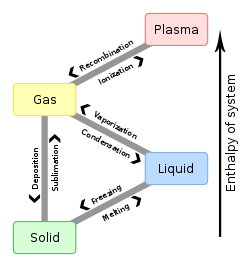This article needs additional citations for verification .(August 2024) |
Matter organizes into various phases or states of matter depending on its constituents and external factors like pressure and temperature. Except at extreme temperatures and pressures, atoms form the three classical states of matter: solid, liquid and gas. Complex molecules can also form various mesophases such as liquid crystals, which are intermediate between the liquid and solid phases. At high temperatures or strong electromagnetic fields, atoms become ionized, forming plasma.
Contents
- Low-energy states
- Classical states
- Condensates, superfluids and superconductors
- Magnetic states
- Electronically ordered states
- Topological states of matter
- Classification by conductivity
- Miscellaneous states
- High-energy states
- References
At low temperatures, the electrons of solid materials can also organize into various electronic phases of matter, such as the superconducting state, with vanishing resistivity. Magnetic states such as ferromagnetism and antiferromagnetism can also be regarded as phases of matter in which the electronic and nuclear spins organize into different patterns. Such states of matter are studied in condensed matter physics.
In extreme conditions found in some stars and in the early universe, atoms break into their constituents and matter exists as some form of degenerate matter or quark matter. Such states of matter are studied in high-energy physics.
In the 20th century, increased understanding of the properties of matter resulted in the identification of many states of matter. This list includes some notable examples.
